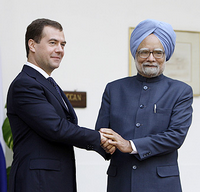During the Cold War, the Soviet Union’s military-industrial complex sustained the massive Soviet military institution, which regularly gobbled up 15-25 percent of the nation’s GDP. In an odd and unexpected twist to the end of the Cold War, the Russian arms industry has turned to sustaining itself by arming a pair of Asian giants: Arms exports to China and India have proven lucrative for Russia -- and have even had a synergistic and competitive quality. The unease each country has felt due to the other increasing its military capability has led to higher revenues for Rosoboronexport, the Russian state-owned arms exporter. For the post-Cold War Russian arms industry, this trade has represented a boon, helping to replace lost customers in the Middle East, Eastern Europe and the Russian military itself. However, this situation is almost certainly unsustainable in the long run, as both China and India appear to be outgrowing their dependence on the Russian military-industrial complex. This will spell trouble for Russia, which has had great difficulty developing exports based on anything other than arms or energy.
A recent series of articles by Dmitri Gorenburg highlighted the extent of the arms trade between Russia and India. The relationship has propelled India to the top spot among arms importers, and Russia to the No. 2 spot -- behind the United States -- among arms exporters. The most visible projects involve the transfer and refurbishment of the former Soviet carrier Admiral Gorshkov, expected to be completed in 2012, and the lease to the Indian navy of a nuclear attack submarine. In addition, substantial transfers of ground and air weapons, not to mention various support equipment, have helped Russia capture 82 percent of India’s enormous arms import appetite.
Russia and India are also involved in several major joint defense projects involving significant technology transfer, including most notably the PAK-FA fifth-generation fighter aircraft and the BrahMos cruise missile. Regarding the former, India may well end up producing and procuring more aircraft than Russia. Indeed, Gorenburg argues that the relationship between Russia and India is increasingly shifting from one of producer-consumer toward a joint-production partnership.

